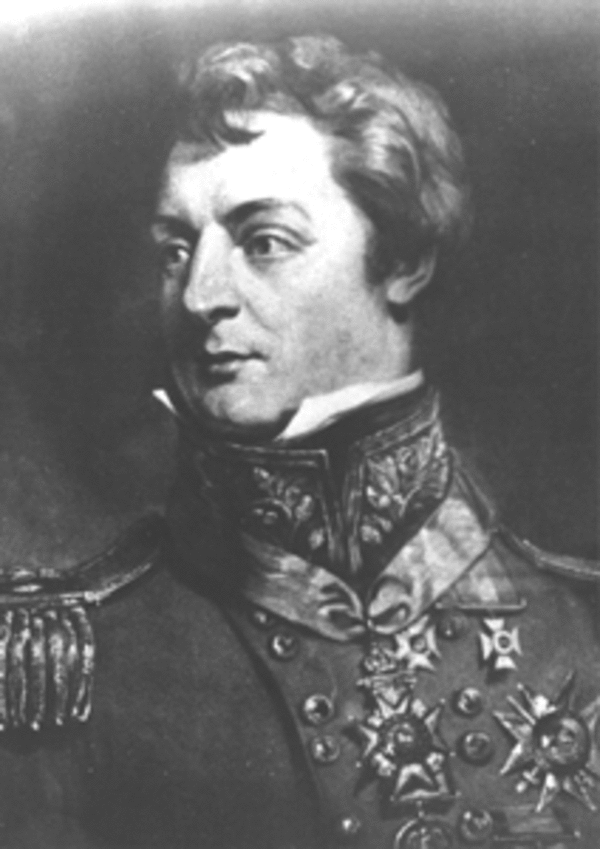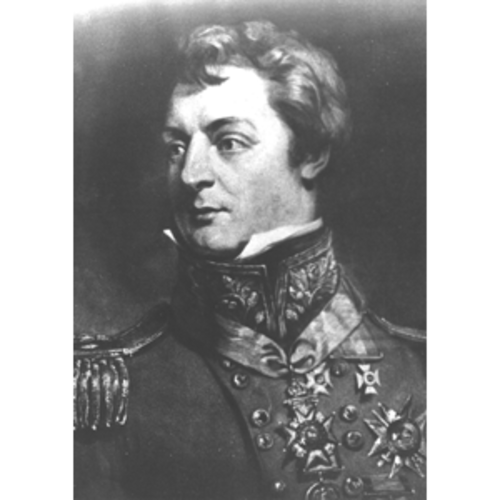
Source: Courtesy of Wikimedia Commons
SMYTH, Sir JAMES CARMICHAEL, army officer, military engineer, and author; b. 22 Feb. 1779 in London, eldest of five sons of James Carmichael Smyth and Mary Holyland; m. 28 May 1816 Harriet Morse, daughter of Robert Morse*, in London, and they had one son; d. 4 March 1838 in Georgetown (Guyana).
The father of James Carmichael Smyth, a doctor and author, sent his son to be educated at the Royal Military Academy in Woolwich (London). Smyth graduated in 1793, became a second lieutenant in the Royal Engineers in March 1795, and served as one of the chief engineering officers with the British forces in southern Africa between 1795 and 1808. During this period he also gained experience as a colonial official. In 1808 and 1809 he was in Spain with Sir John Moore’s command, and between 1813 and 1815 he was one of the principal military engineers with the allied troops in the Low Countries, rising to the rank of brevet colonel by June 1815. At Waterloo he was on the Duke of Wellington’s staff, and for his service he won the duke’s approbation and sundry honours and decorations.
When Wellington took up the post of master general of the Board of Ordnance in 1818, in charge of fixed defences throughout the empire, Smyth became one of his principal executive officers. In 1823 Wellington sent Smyth, who had been created a baronet in August 1821, on tours of the defences and fortifications in the Low Countries and the British West Indies. The 1824 report on West Indian defence needs was the basis for all plans and works in the islands for the next generation. In 1825 Smyth, again on Wellington’s instructions, performed the same service in British North America, and his report, dated 9 Sept. 1825, became the standard plan for fortifications until the mid 1840s. Smyth was promoted major-general in May 1825, and, after some engineering work in Ireland, in May 1829 he became governor of the Bahamas. In June 1833 he moved to the governorship of British Guiana (Guyana). There he helped to smooth out the problems associated with emancipation of the slaves, winning praise in the colony and London for his efforts. He died in this last office of a sudden illness. Between 1815 and 1831 Smyth had published eight volumes on military engineering, defence, and slavery.
The contributions Smyth made to the development of Canada stemmed from his 1825 report, in particular from his promotion of an existing scheme for a canal which would link the Ottawa River and Lake Ontario by the Rideau and Cataraqui river systems. Between April and October 1825 Smyth and two other engineers surveyed the entire frontier between British North America and the United States, travelling back and forth across the Atlantic. Their examination was rather too quick for complete efficiency. In his instructions, Wellington had emphasized the importance of a Rideau canal, and Smyth agreed that such a water-way was the most necessary component in the defence of the colonies. Seizing on some civilian estimates, he used these as a base for projecting a canal which would cost no more than £169,000. This figure was to prove inadequate in a number of ways, but its reasonable size was instrumental in winning Treasury approval. The Smyth commission judged that all the essential defence works for British North America would cost £1,646,218; this sum was too much for the Treasury. But Smyth and Wellington put priority on military canals, and were successful in obtaining funds for them. Without Smyth’s efforts, the Rideau Canal would not have been built.
Wellington put Smyth in charge of the Rideau project in London, and Lieutenant-Colonel John By was sent to do the building. Smyth worried that By had been rushed off without sufficiently specific instructions; when By submitted his first report in July 1826, these worries were substantiated. By complained that £169,000 was an inadequate amount, announced that he would build a system of canals that were over twice the intended width, and added that he was starting work which would cost more than £169,000. Smyth urged Wellington to restrain and discipline By and force him to conform to the original plans and costs. But the communications lag and the inertia within the Ordnance department were too great, and By succeeded in enlarging the project. Unfortunately, much of By’s work was, from the defence point of view, futile, given restrictions on the size of military canals which were being built along the Ottawa River, and By and Canadian defence expenditures fell into deep disfavour in London during 1832 and 1833.
The other service to Canada rendered by Smyth was his book on the campaigns of the British army in North America, called Précis of the wars in Canada, from 1755 to the Treaty of Ghent in 1814, with military and political reflections (London, 1826). He focused on the 1813 and 1814 campaigns, which highlighted the dangers to military water communications along the American border. In other ways the Précis presented a short, orthodox assessment of the American wars.
Smyth’s main Canadian activities are recorded in PRO, CO 42/205: 174; Wellington to Smyth, 11 April 1825; 193–200; WO 44/15: 297; 44/16: 24–25; 44/18: 65–67, 69–72; 44/19: 17–18; 44/24: 269–70; and SRO, GD45/3/390. His part in the Rideau Canal story is related in G. [K.] Raudzens, The British Ordnance Department and Canada’s canals, 1815–1855 (Waterloo, Ont., 1979), and his activities are mentioned in a number of other works relating to Canada’s defences, notably in Kenneth Bourne, Britain and the balance of power in North America, 1815–1908 (London, 1967). There is a four-column entry in the DNB.
Cite This Article
G. K. Raudzens, “SMYTH, Sir JAMES CARMICHAEL,” in Dictionary of Canadian Biography, vol. 7, University of Toronto/Université Laval, 2003–, accessed December 20, 2025, https://www.biographi.ca/en/bio/smyth_james_carmichael_7E.html.
The citation above shows the format for footnotes and endnotes according to the Chicago manual of style (16th edition). Information to be used in other citation formats:
| Permalink: | https://www.biographi.ca/en/bio/smyth_james_carmichael_7E.html |
| Author of Article: | G. K. Raudzens |
| Title of Article: | SMYTH, Sir JAMES CARMICHAEL |
| Publication Name: | Dictionary of Canadian Biography, vol. 7 |
| Publisher: | University of Toronto/Université Laval |
| Year of publication: | 1988 |
| Year of revision: | 1988 |
| Access Date: | December 20, 2025 |



